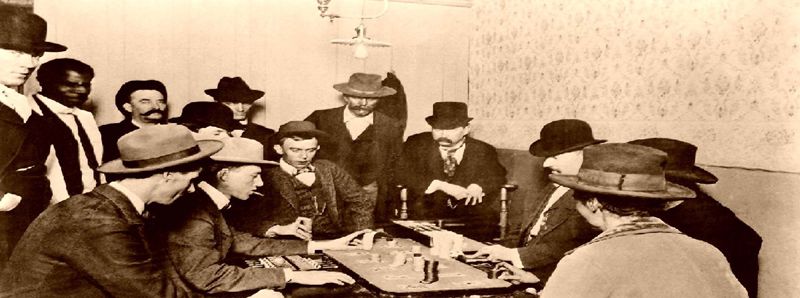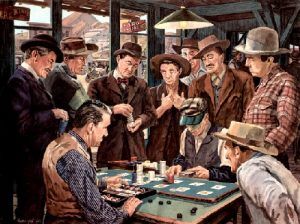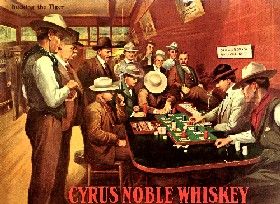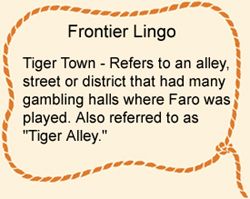Faro, or “Bucking the Tiger” – Legends of America (original) (raw)
Faro gambling card game about 1900.
Faro is a gambling card game that was a derivation of a card game called Basset. Faro originated in France in the late 17th century. First known as Pharaon, it became extremely popular in Europe in the 18th century. With its name shortened to Pharo or Faro, it soon spread to America and became the favored game during the California Gold Rush. The game then spread into gambling halls all over the American Frontier, with such illustrious names as Doc Holliday and Wyatt Earp, often performing the task of a Faro Dealer.
Not a direct relative of poker, Faro was played alongside its other popular counterpart and played by the masses due to its fast action, easy-to-learn rules, and better odds than most games of chance. From 1825 to 1915, the game was the most popular enticement in almost every gambling hall in the American West.
Though the rules are similar to Mini-Baccarat, Faro is played with only one deck of cards and allows for any number of players, referred to as “punters.” The Faro dealer was called the “banker.”
The Faro layout consists of a board where one card of each denomination is displayed at the top of the table, usually in the suit of spades. As the game commenced, each player would lay their stake on one of the 13 cards or place multiple bets on different cards. There was also a “high card” box at the top of the layout, which players could bet on.
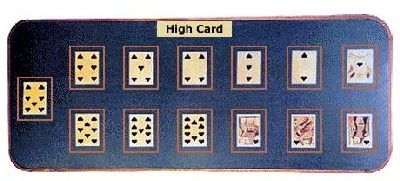
Faro Board
After the banker burned a card, he would then deal a card, referred to as the “banker’s card,” and place it to his right. He would then deal another card, called the “English card” or “player’s card,” placing it to his left.
The banker would win all the money staked on the “banker’s card” while paying double the sums staked to those who had placed their bet on the “player’s card.” If the banker dealt a pair, he won half the stakes that were bet on the card. In a fair game, this provided the only house edge. Gamblers could also wager on the “High Card” bar at the top of the layout, betting that the “player’s card” would be higher than the “banker’s card.”
Faro in Tonapah, Nevada in 1905
When these rules are reviewed, it becomes apparent, that there is no significant edge for the dealer, or “house, which resulted in cheating by the “banker” becoming commonplace. Trick decks, sleight of hand, and forms of modified automatic dealing boxes were employed to give the house a better advantage.
Cheating became so prevalent that editions of Hoyle’s Rules of Games book began their Faro section with a disclaimer, warning readers that an honest faro bank could not be found in the United States.
One of the better-known cheating dealers was Soapy Smith, who had every one of his Faro games rigged at his Tivoli Club in Denver, Colorado.
A popular phrase that was often associated with Faro was “Bucking the Tiger,” which is thought to have come from early card backs that featured a drawing of a Bengal Tiger. Another phrase that referred to playing Faro was “twisting the tiger’s tail.” Places that sported several gambling halls, including alleys, streets, and districts, were often called “tiger town” or “tiger alley.”
Faro Players
Due to the extremely low odds for the house, legitimate Faro was virtually gone by 1925. However, when the State of Nevada legalized gambling in 1931, the game made a short revival, but by the 1950s, it had gone out of fashion once again, as more profitable house games such as craps and roulette were promoted by the casinos.
By this time, there were only five active faro banks known to have been in existence in Nevada, the last of which was in Reno and closed in 1985.
Today, the vast majority of young American gamblers have never even heard of Faro.
© Kathy Weiser-Alexander/Legends of America, updated November 2021.
“A dollar picked up in the road is more satisfaction to you than the ninety-and-nine which you had to work for, and money won at faro or in stock snuggles into your heart in the same way.”
— Mark Twain in 1892
Frontier Lingo – Faro
Also See:
